1. CONFINEMENT FOR 3 WEEKS.
Keep the puppy confined in the play pen (puppy pen) or small area of
around 6 sq ft (e.g. Shih Tzus). The sizes depends on the breed. The
play pen is placed in the balcony, kitchen, outside the toilet.
If you don't buy the play pen, choose an area in the balcony, spare
utility room or kitchen. Block the area using a baby gate or fence.
Keep the puppy confined for most of the time in the first 3 weeks.
 2.
100% NEWSPAPER COVER. Cover the whole floor with newspapers. 2.
100% NEWSPAPER COVER. Cover the whole floor with newspapers.
3. ACTION. When the puppy circles, moves forward and backward
or sniffs around, it wants to urinate or defaecate. Say to the puppy
"Wee Wee" or any word you like JUST BEFORE it has relieved itself.
5. LAVISH PRAISE AND/OR REWARDS. After it has relieved
itself, give it a small treat and say in a HAPPY voice "Good dog" or any
word you like.
6. Replace the soiled
newspaper as soon as possible if you are at home. Soon, you will
note that it will choose one spot as it wants to keep its sleeping area
clean.
7. Gradually remove the newspaper (e.g. 5 cm by 5 cm per day) till
only the newspaper covers only the area the puppy uses to relieve itself.
Give the puppy a towel to sleep on but it may chew it. Give it one good
quality chew toy or a chew toy with food.
8. When the puppy is paper-trained, put newspapers outside the
confined area in a bigger area of the apartment so that the puppy can
relieve itself on the newspaper. This is because the puppy will not be
able to get into the play pen (if it has no door). It may whine to
ask you to put it in the play pen but you may not be free to note that it
wants to go to the toilet. Some pet shops recommend a second water
bottle to be put on the outside of the play pen so that the puppy can
still have water to drink after it has been toilet trained. It uses the
play pen as its den to sleep and eat.
9. Position the puppy near to family activities as the puppy is a
social creature. Most Singaporeans keep the puppy in the kitchen, balcony
or living area.
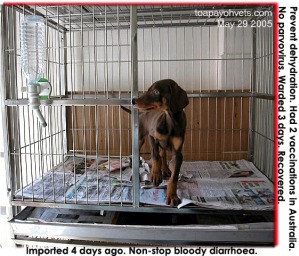
A cage sold by the pet shop.
3 feet long and 2 feet wide.
NOTES: 1. From 8 - 20 weeks old, the puppy relieves
itself around 10 times per day.
When it stops growing at around 8 months old (for a small breed),
the number goes down to 2-4 times. When the 8-week-old puppy
is taken out to play, it will usually relieve itself after two
hours.
2. The puppy usually relieves itself overnight, early in the
morning, after each meal, after a rest period and before sleeping.
Stick to the ROUTINE of feeding on time. It is recommended
that 8-12-week-old puppies are fed three times a day and the feed
removed after 20 minutes. For 6-10-week-old chihuahuas, it may
be necessary to provide feed over-night.
3. HITTING THE PUPPY AND SMELLING SHIT. Some Singaporeans use
some objects to beat the puppy when it has passed stools all over
the apartment, force the puppy to smell the stools and then bring it
to the newspaper to tell it to relieve itself there. The puppy
runs away or growls at the disciplinarian. It does not know
why it is pushed to smell its own stools or yelled at and associate
the person with unpleasant feelings. It relieves itself after the
person is not around. It eats up the stools to "hide the evidence".
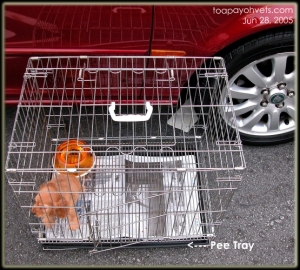
Some Singapore pet shops
recommend the wire crates with a door for new puppy owners.
The puppy can see everybody. It tends to play or overturn the water
bowl but will not be able to shred the newspapers. The urine falls
down to the pee-tray's newspapers, keeping the puppy drier and not
soiling the tiles of the apartment. The stools may need to be picked
up regularly. The crate is foldable. It costs around S$50.00 for the
small breeds and are more expensive than the 4 pieces of fencing for
the playpen (puppy pen). The fences may collapse onto the puppy.
4. FAMILY CO-OPERATION. Toilet training needs every
member of the family to supervise the puppy and give the same
commands. If "pooh" is used and another family member say "shit",
the puppy gets confused.
5. BUSY WORKING COUPLES. Evenings and weekends may be needed to
toilet train the puppy. They will find that the newspapers have been
shredded when they return from home. Do not be angry. It
will be good if the new owner can take leave for a few days to
toilet train the puppy. If not, persist in paper training and most
puppies will be toilet trained in 3 weeks. |
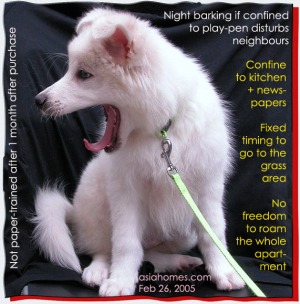
Leash training is another way to toilet train your puppy.
6. YOUNG CHILDREN.
Unfortunately, young children play with the puppy for long hours and
this affect the success of toilet training! Explain to the
children the need for confinement.
7. RUGS AND CARPETS. If you can't stand the puppy
whining on its first night alone, you can move the cage or play pen
in your bedroom or switch on a radio. If the puppy sleeps on
your bed, provide a rug (and several rugs in the apartment) as the
puppy loves to relieve itself on soft material. It does not
want to dirty its sleeping area.
8. BUYING TWO PUPPIES. The same toilet training procedures apply,
with each puppy being confined separately. Most owners house two
puppies together and this is hard for the cleaner puppy to relieve
itself on the same spot in the newspaper when the mate dirties
the whole area.
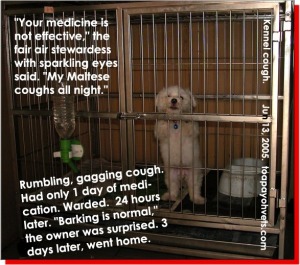
Dual bowls may be harder to be over-turned by the
puppy. Aluminium and stainless steel cages are seldom bought by
the puppy owner as they are expensive.
9. PAPER
TRAINING is the most common method of toilet training the puppy in
Singapore where around 90% of the population live in apartments.
Other than newspapers which don't cost money, PUPPY TRAINING PADS
with scent of urine are bought by some owners from the pet shops and
used for paper
training.
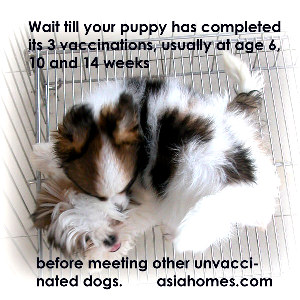
ABANDONED PUPPY. A
puppy that has not been toilet trained properly may suffer from
beatings and then given away. It is hoped that this education
article has sufficient basic information to start training your new
puppy. It will never ever be abandoned by you or your family members
for being "messy" and smelly if you have the knowledge and time to
toilet-train your best friend. |
REFERENCES
|
8.
Platform training + crate + play pen 2 puppies |
|
7.
Toilet training mistakes |
|
6.
Six-month-old Maltese keeps peeing on tiled floors |
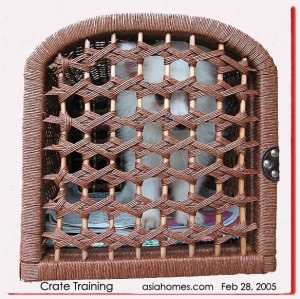 |
8.
Crate training. Confine in crate for one hour. Every hour, on
the hour, take out the puppy and put it onto the play-pen with
newspapers or a pee tray with newspapers to pass urine/stools.
Increase the duration of crate confinement as the puppy grows
older. As a general guide, a 2-month and 3-month-old
puppy is crated for 2 and 3 hours respectively. However,
commence training starting from 1 hour first and supervise.
This method is effective if the domestic worker or somebody is
at home. |
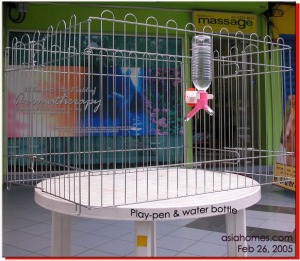 |
9.
The typical play pen (puppy pen) sold by most pet shops to
puppy owners in Singapore. The play pen confines the puppy so
that it does not soil the apartment. Newspapers are placed
inside the play pen. The puppy is given 2 meals a day and
water from the water bottle. The puppy food is taken away
within 15 minutes if the puppy does not finish eating.
For chihuahuas and mini-Malteses, extra feeding and supervised
feeding is advised. A honey-paste is given to such small
breeds. Costs around $80.00
|
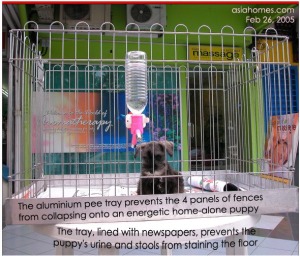 |
10.
A pee tray encloses the play pen to prevent the fences
collapsing onto the puppy, especially the bigger breeds. The
tray prevents the tiled or marble floor from being stained by
the puppy's urine or stools. Costs around $150.00.
The use of water bottles is not sanctioned by the local animal
shelter but some puppies just get wet playing with water when
given the water bowl. |
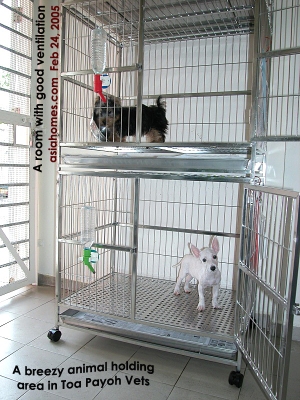 |
11.
Various types of cages (crates) are bought by puppy owners.
The stainless steel cages cost around $300. Inexpensive ones
are made of wires enclosed by plastic. There are
plastic/fiberglass crates with ventilation holes and only the
front metallic door. Such crates are good for puppies who chew
and dig and can be used for travel.
If you use cages, some puppies can hop in and out of the cages
to a confined toilet area where newspapers are placed. For
short-legged ones like the Yorkshire Terrier, they are taken
out.
Some owners just place newspapers inside the cage and let the
puppy be paper-trained. Shredding of newspapers is the common
complaint. |
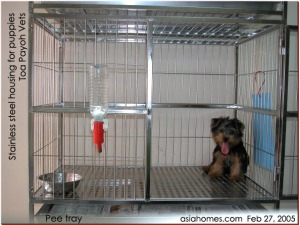 |
12.
The holes on the cage floor lets urine pass through and keeps
the puppy cleaner. The newspapers below the floor catches the
urine. This cage set up is commonly used by Singapore's pet
shop operators to house puppies for sale. However, some
pet shops have built-in cages.
You can see that the puppy is not paper-trained at most pet
shops since they seldom contact the newspapers directly.
Surprisingly, some puppies immediately use the newspapers as
the toilet area when brought home. The use of the
house-breaking aid, bought from the pet shop, sprayed onto
the newspapers is useful in some cases and ineffective for
others. |
|
It is not possible to provide comprehensive
information on this webpage. E-mail
judy@sinpets.com or phone +65
9668-6468 if you are interested in buying or advertising in the book:
Be Kind To Pets: Toilet Training Your First Puppy - Dr Sing's Puppy Book
For Singaporeans
Dr Kong Sing, BVMS (Glasgow), MRCVS. Publication is expected in
December 2005. |
 2.
100% NEWSPAPER COVER. Cover the whole floor with newspapers.
2.
100% NEWSPAPER COVER. Cover the whole floor with newspapers.